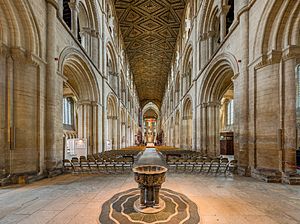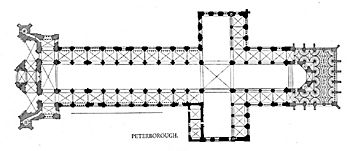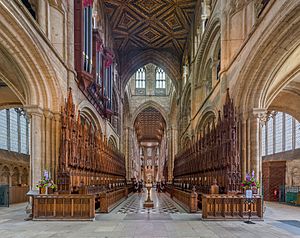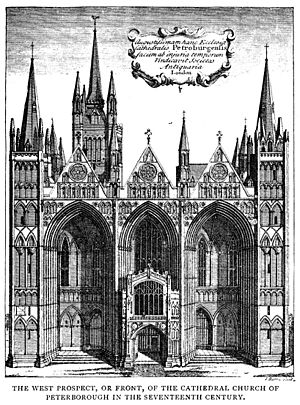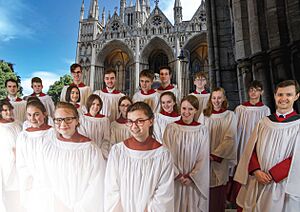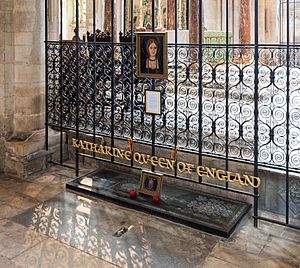Peterborough Cathedral facts for kids
Quick facts for kids Peterborough Cathedral |
|
|---|---|
| The Cathedral Church of St Peter, St Paul and St Andrew | |
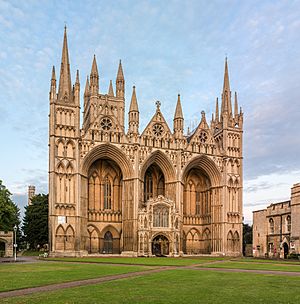
Peterborough Cathedral
|
|
| 52°34′21″N 0°14′20″W / 52.5725°N 0.238889°W | |
| Location | Peterborough, Cambridgeshire |
| Country | England |
| Denomination | Church of England |
| Previous denomination | Roman Catholic |
| Website | Peterborough Cathedral |
| History | |
| Dedication | St Peter, St Paul, St Andrew |
| Consecrated | 1238 |
| Architecture | |
| Style | Romanesque/Gothic |
| Years built | 1118–1237 |
| Specifications | |
| Nave length | 147 m (482 ft) |
| Height | 44 m (144 ft) |
| Number of towers | 4 |
| Number of spires | 2 |
| Administration | |
| Diocese | Peterborough (since 1542) |
| Province | Canterbury |
Peterborough Cathedral is a very old and important church in England. Its full name is the Cathedral Church of St Peter, St Paul and St Andrew. It is also called Saint Peter's Cathedral. This amazing building is the main church for the Bishop of Peterborough, who is a leader in the Church of England.
The cathedral is dedicated to three saints: Saint Peter, Saint Paul, and Saint Andrew. You can even see their statues on the front of the building! While the church started way back in the Anglo-Saxon times, most of what you see today was built in the 12th century. This was after it was rebuilt in the Norman style.
Peterborough Cathedral is famous for its huge and impressive West Front, which is the main entrance. It has three giant arches that are unique and beautiful. If you look closely, you might notice that one of the two towers behind the front was never fully finished. But you can only really tell from far away!
Contents
History of Peterborough Cathedral
How the Cathedral Began: Anglo-Saxon Times
The very first church on this spot was called "Medeshamstede". It was founded around 655 AD by King Peada of the Middle Angles. This made it one of the first places where Christianity began to spread in central England.
The church and its monastery (a community of monks) lasted until about 870 AD. At that time, Vikings attacked and destroyed it. Inside the cathedral today, you can find an old stone carving called the [Hedda Stone]. This carving shows 12 monks and remembers the monastery's destruction and the monks' deaths during the Viking raid in 864. The Hedda Stone was likely carved later, after the monastery started to decline.
In the mid-900s, there was a big effort to bring monasteries back to life in England. A new Benedictine Abbey was started here in 966. Athelwold, the Bishop of Winchester, helped a lot. He built a new church with halls and gave it land. The church was dedicated to St Peter. It was surrounded by a strong fence called a "burgh." This is how the town around the abbey got its name: Peter-burgh, or Peterborough.
This newer church had a tall western tower. Only a small part of the old Anglo-Saxon church's foundations remains today. But you can still see some amazing Anglo-Saxon carvings, like the Hedda Stone, from that early building. In 2008, old Anglo-Saxon grave markers were found near the cathedral. They are thought to be from the 11th century and belonged to local people.
Building the Cathedral: Norman and Medieval Times
The church was damaged during fights between the Norman invaders and a local hero named Hereward the Wake. But it was fixed and continued to grow. Sadly, an accidental fire destroyed it in 1116. This meant a brand new church had to be built.
Construction started on March 8, 1118, in the Norman style. By 1193, the main part of the church, called the nave, was finished. This included the central tower and the beautiful wooden ceiling of the nave. This ceiling, finished between 1230 and 1250, is very special. It's the only one of its kind in Britain and one of only four in all of Europe! It has been repainted twice but still looks like the original.
The cathedral was mostly built using Barnack limestone. This stone came from quarries owned by the church. Other cathedrals even paid Peterborough in thousands of eels each year to use these quarries! Historians believe the cathedral was built in its current spot because it was easy to transport the heavy stones by river.
After the main building was done, the builders started adding the Great West Front Portico in 1237. They then switched to a newer style called Gothic. Except for some window changes and a new building at the east end in the 1500s, the cathedral looks much like it did when it was finished almost 800 years ago. The completed building was officially opened in 1238.
The three huge arches of the Great West Front are what make Peterborough Cathedral so famous. There's nothing else like them in medieval architecture. The four towers behind them were kept from the earlier Norman design. Instead of tearing them down, the builders decorated them in the Gothic style. Two new towers were added to create a continuous front.
The Norman central tower was rebuilt between 1350 and 1380 in the Decorated Gothic style. Its old roof was replaced with battlements. Between 1496 and 1508, the roof of the Presbytery (the area around the altar) was replaced. Also, the "New Building" was added at the eastern end. It has beautiful Perpendicular fan vaulting, which is a special type of ceiling design.
Life in the Monastery
Old records from the 12th century show that the Abbey had many important reliquaries. These were containers holding special items, like pieces of the clothes that wrapped baby Jesus, parts of his manger, and even a piece of the five loaves that fed 5,000 people! There were also relics of Mary the mother of Jesus, Aaron's rod, and parts of St Peter, St Paul, and St Andrew.
These special items made Peterborough Abbey very important. Before the monasteries were closed down by King Henry VIII, it was one of the richest monasteries in England. It had 120 monks and many other staff.
Tudor Times
In 1541, King Henry VIII closed down many monasteries in England. During this time, the relics at Peterborough were lost. However, the church survived because it was chosen to become the main church, or cathedral, for the new Anglican Diocese of Peterborough.
King Henry VIII's first wife, Catherine of Aragon, was buried here in 1536. Even today, visitors honor her grave with flowers and pomegranates, which were her symbol. The gold letters on her tomb say "Katharine Queen of England," a title she was not given when she died. A festival is held every year to remember Queen Catherine.
In 1587, the body of Mary, Queen of Scots, was first buried here after she was executed at nearby Fotheringhay Castle. Later, her son, King James I of England, had her body moved to Westminster Abbey.
From Civil War to Today
During the English Civil War in 1643, Parliamentarian soldiers damaged the cathedral. Many things were destroyed, including almost all the stained glass windows and the medieval choir stalls. The main altar and its decorations were pulled down, as were the cloisters (covered walkways) and the Lady Chapel. Many monuments and memorials were also damaged.
Some of the damage was fixed in the 17th and 18th centuries. A major restoration project began in 1883 because large cracks appeared in the main tower's pillars. This work included rebuilding the central tower and its foundations. New choir stalls, the bishop's throne, and the marble floor were added.
On November 22, 2001, a fire broke out in the cathedral. It is believed to have been started on purpose. Luckily, a staff member saw the fire quickly, and emergency services responded fast. The fire was near the organ, and the smoke and water caused a lot of damage. The organ had to be completely rebuilt and was out of use for several years.
In July 2006, a big project began to repair the West Front. The statues in the niches (small alcoves) were badly damaged by pollution and weather. Some were only held together by iron bars! This repair work cost a lot of money, and people were asked to "adopt a stone" to help pay for it.
Cathedral Music
The Choir
Peterborough Cathedral has had a choir since it was first a monastery. The choir continues to play an important role in the cathedral's services and events today.
The Organ
The cathedral has a magnificent organ. You can learn more about it on the official website: Peterborough Cathedral Organ.
Famous Organists
Records show that Richard Storey was an organist here in 1540. Some well-known organists who have worked at Peterborough Cathedral include Stanley Vann, Sir Malcolm Sargent, and Sir Thomas Armstrong.
Important Burials
Many important people are buried at Peterborough Cathedral. Here are a few:
- Kyneburga, Kyneswide and Tibba: These three women are considered saints. Kyneburga founded an abbey and was buried there. Later, her remains and those of her sister Kyneswide and relative Tibba were moved to Peterborough Abbey.
- Catherine of Aragon (1485–1536): She was the Queen of England and the first wife of King Henry VIII. Her grave is still honored by visitors today.
- Mary, Queen of Scots (1542–1587): After her execution, she was first buried in Peterborough. Later, her body was moved to Westminster Abbey.
- Robert Scarlett ("Old Scarlett") (1496–1594): He was the sexton (gravedigger) of the cathedral for many years. He even dug the graves for both Catherine of Aragon and Mary, Queen of Scots. His memorial is inside the cathedral.
Other Memorials
The cathedral also has memorials for other notable people, including:
- George Alcock (1912-2000): A famous astronomer.
- Edith Cavell: A nurse who was executed during World War I.
Images for kids
-
The cathedral as shown on a frieze at the Royal Albert Hall.
-
A French enamel casket made around 1180. It held relics of Thomas Becket.
See also
 In Spanish: Catedral de Peterborough para niños
In Spanish: Catedral de Peterborough para niños
- List of Gothic cathedrals in Europe
- List of cathedrals in the United Kingdom
- Peterborough Chronicle
- The King's School, Peterborough
- Architecture of the medieval cathedrals of England
- English Gothic architecture
- Romanesque architecture
- Church of England


